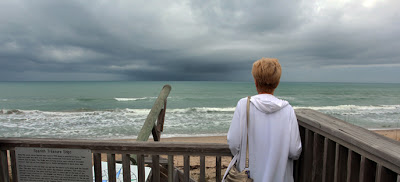One of several buildings in the Indian River County (Vero Beach, FL) Administration complex is shown in all its sub-tropical delight (above) while immediately behind this opulent building is the main hub for the county's bus system (below) where a collapsed sign greets passengers, and in the lower view, the only amenity is a pair of portable toilets lumped in the corner of the hub's parking lot while passengers wait--as the sign directs--before boarding their buses.
SOMEHOW I EXPECTED BETTER--
I caught the bus at its stop at a shopping center located within walking distance of our RV park on the south edge of town and was whisked into the bus line's hub in the central business district about 25 minutes later.
There are 14 routes in the system and their bus-stop signs literally cover this large county's area.
Sue was on an out-of-town junket with our friends, the Weeks, so it was an ideal time for me to go exploring.
The service is known for its reliability and departed on time. At the hub my plan was to change buses to a line that ran north completely out of the county between Sebastian and Melbourne. There I could loiter a bit along the inter-coastal waterway in Sebastian then catch a later bus back to Vero and, with another change, back to my starting point.
While the system's--known as the GoLine--equipment is modern and apparently well maintained and the drivers were, without exception, friendly and courteous, I was astonished to find a nearly bare parking lot for the "hub" rather than a nice building with amenities common to modern public transportation.
Surely there would at least be a shelter from the rain with a few flush toilets and a place to rest while waiting for one's departure.
Nope.
The county building (above) is a dandy but the bus facilities around back were a slap in the face to the GoLine's customers.
It was evident those folks were given consideration that mirrored their, evidently, modest social class.
The first hint was the complete absence of modern, "droid" type cell phones. Clothing was not exactly designer inspired. These were the working folks and I suspect many of the bus customers were not inclined to vote.
Politicians in control of the purse strings tend to be aware of such things.
Regardless, I noted our driver on the Sebastian run knew her passenger Edward who swapped greetings with fellow passenger Rich. These folks were regulars.
The driver even had her lunch handed to her through a window and had 6 minutes to consume it before the next scheduled departure. It was delivered, compliments of her husband who I met later and who just happened to be in the area.
Forget the class limitations and enjoy the civility.
On the way back to my starting point I noticed a very modern, artistic even, covered bench, gaily painted, at a bus stop. I wondered what political big shot lived nearby.
I was riding with Valerie, a 50-year resident of Vero Beach and we discussed the dismal facilities at the downtown hub. She summed it up cogently by noting, "When it rains we get wet."
Below is a view at the hub looking East. That is the only bench that was in view in any direction and it was occupied by a person who appeared to be homeless.
Actually, he could have arrived there by bus. The service is by donation.


































